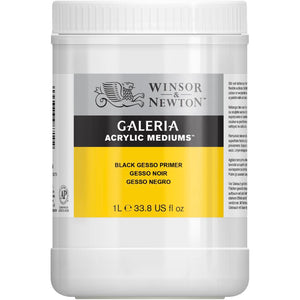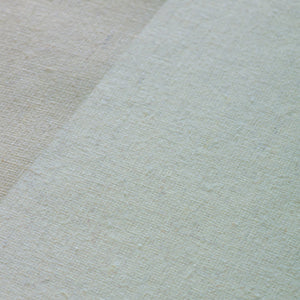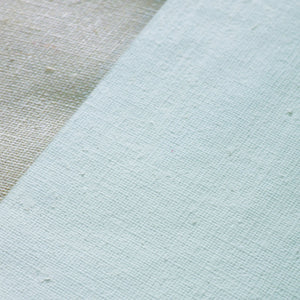
What is acrylic gesso?
Gesso is a white paint mixture consisting of a binder mixed with chalk, gypsum, pigment, or a combination of all three. Acrylic gesso is an alternative to real gesso, possessing a similar absorbency or tooth that one expects from a gessoed surface.
Clear acrylic gesso allows the natural colour of the canvas to show through, whereas white or tinted acrylic gesso will give your painting a toned ground base layer. You can see the effects created with different gessoes in the video below.
How should I apply gesso?
It’s best to use a wide, flat brush with relatively short bristles to apply gesso, and brush it in firmly in one direction only. Ensure the gesso sits on the surface of the canvas. Thinning the first coat with a little water makes it easier to apply and helps the gesso soak into the first layers of the canvas. When the first coat has dried, apply the new coat in the opposite direction and allow to dry. For your final coat apply in the same direction as your first. This will ensure you have an even ground across your canvas that creates a protective layer between your paint and the canvas.
Read our ultimate guide to priming your canvas for more information.
How many coats of gesso do I need?
As an average, about three coats. For acrylic paintings, one or two coats of gesso are normally recommended. For oil paintings, you need two to four coats. But the precise number of coats depends on the absorbency of your surface and your personal preference.
How long does gesso take to dry?
Although gesso can be touch dry within one to two hours, depending on temperature, it’s best to wait at least 24 hours before painting on a gessoed surface. You should also wait at least an hour between coats. Keep in mind that sometimes humidity and temperature changes can affect the drying time of gesso.

Can I prime canvas without gesso?
You can use other primers after sizing with rabbit skin glue. If you don’t prime or gesso your canvas it is likely to rot over time when directly in contact with your paint.
Can you gesso over oil paint and reuse the canvas?
No – you can paint over old paintings but not re-gesso or prime over oil. If you have an acrylic painting you no longer want and you would like to reuse the canvas, start by lightly sanding the work to make the surface even. Then you can paint over it with gesso, before starting again with a new painting
Are WN Canvases already primed? If so, why would you use Acrylic Gesso to prime a ready-made canvas?
All our canvases are primed with a of minimum 3 coats of highly pigmented gesso. So no additional priming is needed. What can give a different painting experience is when the artist applies a few additional coats and then sands the surface to eliminate the cotton/linen texture. But purely optional then.
Can I apply Oil primer to the Acrylic Gesso-primed canvas? How long should I wait after priming?
Yes, it is perfectly fine to apply oil primer over the acrylic gesso primed canvas. It should dry overnight, and you can then continue painting.






![W&N BLACK FINELINER LS 0.1 [CAP ON]](http://uk.winsornewton.com/cdn/shop/files/64128.jpg?crop=center&v=1736866967&width=20)
![W&N COTMAN WATERCOLOUR 8HP FLORAL POCKET SET [FRONT]](http://uk.winsornewton.com/cdn/shop/files/97499.jpg?crop=center&v=1738930795&width=20)
![WN COTMAN FLORAL POCKET SET 9PC 884955081129 [DHI]](http://uk.winsornewton.com/cdn/shop/files/136686.jpg?crop=center&v=1738930795&width=20)

![WN PROMARKER COOL GREY 3 [COMPOSITE] 884955041406](http://uk.winsornewton.com/cdn/shop/files/77586.jpg?crop=center&v=1741263144&width=20)
![W&N SERIES 7 KOLINSKY SABLE BRUSH ROUND [SHORT HANDLE]](http://uk.winsornewton.com/cdn/shop/files/11424.jpg?crop=center&v=1740568148&width=20)

![W&N GALERIA ACRYLIC TUBE 60ML TITAN WHITE 08 [COMPOSITE] 094376914061](http://uk.winsornewton.com/cdn/shop/files/9396.jpg?crop=center&v=1714072593&width=20)
![W&N GALERIA [SWATCH] TITANIUM WHITE](http://uk.winsornewton.com/cdn/shop/files/3097.jpg?crop=center&v=1714072593&width=20)
![W&N GALERIA CARDBOARD SET 10X12ML 884955097809 [OPEN]](http://uk.winsornewton.com/cdn/shop/files/138856.jpg?crop=center&v=1725031476&width=20)
![W&N GALERIA CARDBOARD SET 10X12ML [B014096] 884955097809 [FOP]](http://uk.winsornewton.com/cdn/shop/files/138855.jpg?crop=center&v=1725031475&width=20)